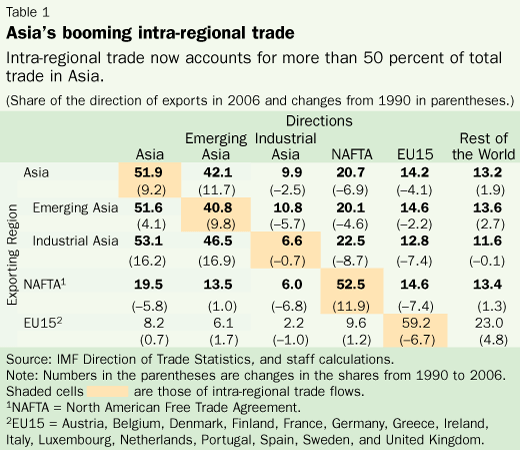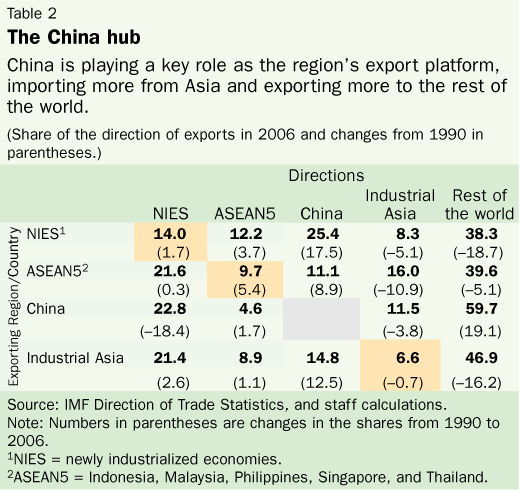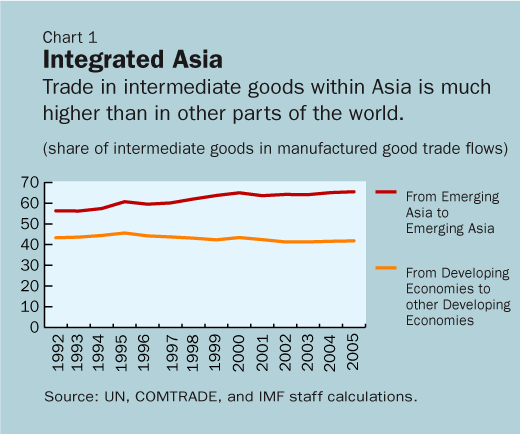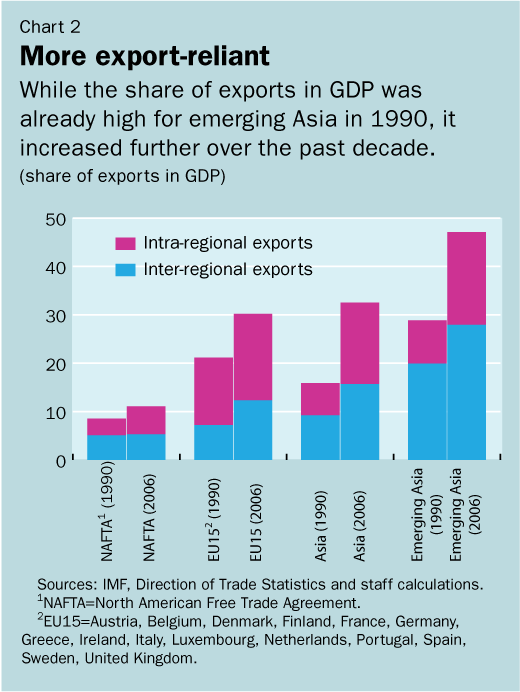
Typical street scene in Santa Ana, El Salvador. (Photo: iStock)
IMF Survey: Intra-regional Trade Key to Asia's Export Boom
February 6, 2008
- Emerging Asian exports now account for more than one-third of world trade flows
- Asian export boom supported by intra-regional trade, with China as a hub
- Vertical specialization leverages differences in Asian comparative advantage
As almost any shopper in the industrialized countries knows, Asian exports are booming, with growth built increasingly around rapid growth in intra-regional trade that has China playing a central role.

Engineers set up turbine rotor in China, where exports are growing in sophistication (photo: Peter Bowater/Stock Connection)
Asian exports
Despite the current slowdown in the world economy, the IMF projects Asian growth to moderate only slightly, with developing Asia growing by a projected 8.6 percent in 2008. China's growth is forecast to slow to 10 percent from an estimated 11.4 percent in 2007.
The export boom reflects a still-ongoing geographical dispersion of production, with assembly operations migrating to lower-wage economies, while more developed Asian economies specialize in production of high-value-added components and capital goods.
The resulting increase in vertical intra-industry trade, fostered by foreign direct investment, has created a sophisticated production network in emerging Asia, facilitating the "catch-up" process of developing Asian countries through technology transfer. India also is making its mark, albeit in services trade, which is outside of the production networks of East Asia.
Growing share of world trade
The export-oriented growth strategies of emerging Asian economies have been reflected in a steady increase of their share in world trade. The share of emerging Asia in world trade flows reached 34 percent in 2006, up sharply from 21 percent in 1990. Moreover, the rise in emerging Asia trade accounted for roughly 40 percent of the total increase in world trade over the period.
The importance of exports to the region has reached an unprecedented level. While the share of exports in GDP was already high for emerging Asia in 1990, it increased further over the past decade, reaching almost 50 percent in 2006. This is attributed in part to the small open newly industrializing economies (NIEs), especially Hong Kong SAR and Singapore, for which the exports-to-GDP ratios are 109 and 184 percent, respectively. However, high and rising exposures of other economies in emerging Asia, including China, suggest that this trend is key to understanding economic developments in the region.
China as Asia's regional export hub
Asia's growing share of world trade has resulted largely from increased regional trade integration. While trade flows in the rest of the world roughly tripled between 1990 and 2006, inter-regional trade involving emerging Asia rose by 5 times, and intra-regional trade within emerging Asia increased by 8½ times. As a result, trade between the economies in emerging Asia has risen steadily from about 30 percent of total exports by the region in 1990 to more than 40 percent in 2006 (see Table 1).

China has become Asia's export hub, dramatically raising its position as a destination for intra-regional exports and the source of exports from Asia to the rest of the world (see Table 2).

Vertical specialization
Intra-industry trade is also booming. This trend in emerging Asia tracks developments in the more advanced economies, but the motivation in Asia is quite different.
Intra-industry trade in emerging Asia is primarily a reflection of greater vertical specialization that exploits differences in comparative advantage to build a production network targeting foreign markets. In contrast, intra-industry trade in the developed economy groups (the North American Free Trade Agreement and the European Union) appears to stem primarily from demand for product variety in the context of their large domestic markets. This difference can be seen clearly in the increasing intermediate goods trade in Asia (see Chart 1).

The share of intermediate goods in trade flows into emerging Asia has increased to 65 percent, while the share in trade flows among more developed economies is about 40 percent. On the other hand, the share of intermediate goods flowing from emerging Asia to the more developed economies is low, at around 30 percent, as exports to the rest of the world tend to be final goods.
Moreover, a recent IMF staff study finds that the pattern of intra-regional trade remains broadly in line with countries' levels of economic development, suggesting a complementary relationship aimed at leveraging differences in comparative advantage among countries in the region.
Implications
What are the implications of growing interdependence among economies in emerging Asia?
1. Decoupling is unlikely. Given the increasing share of intra-regional trade, it may be tempting to argue that emerging Asia can decouple from the global economy. However, this is likely not the case. Developed economies outside the region remain the main destination of final good exports by emerging Asia. Indeed, the exposure of Asian economies to inter-regional exports has actually increased over the past 15 years (see Chart 2).

2. The impact of exchange rate fluctuations on Asian final good exports may be limited. Given that the export processing trade accounts for an important share of total trade, exchange rates may have only a limited impact on export prices of final goods. Why? Exchange rates changes will be mitigated by a countervailing movement of import prices that represent a sizable portion of production costs. However, the observed shift of trade toward higher-end Asian export products suggests that exports and imports could become more sensitive to the relative price changes over time.
3. Policies are needed enhance complementarities. Booming intra-regional trade seems likely to continue to facilitate the "catching up" process through technology transfers from more advanced economies to less advanced "latecomers." In this regard, structural reforms in the leading countries to encourage smooth upgrading of their technological competitiveness, such as those in labor and financial sectors to facilitate the reallocation of resources along the lines of comparative advantage, are important. So is the further easing of trade and investment barriers in the region more generally.
4. Free trade arrangements can help. Given the structure of vertical intra-industry trade in Asia, with final goods targeted at the developed economies (outside the region), market access to third countries, especially in Europe and North America, appears to be crucial for further trade expansion, and hence for industrial development. A successful Doha Round is obviously in the interest of the region. Additionally, well-designed bilateral free trade arrangements with developed economies may also benefit the region as long as they complement trade liberalization on a nonpreferential basis.
For more information, please see Chapter 4 of Asia and Pacific Regional Economic Outlook, October 2007.
Comments on this article should be sent to imfsurvey@imf.org.







